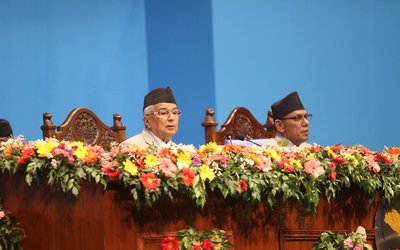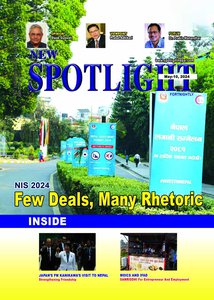
I had wanted to write on this subject in the last week of January when conditions were really bad for us denizens of Kathmandu. Then came the Maghe jhari - the conditions improved and life became easier. I too then transformed, became like the 'Cheparo idling in the sun' and forgot all the discomforts that I had been going through. Now that I am like 'Back to Mangalman', I am writing about it!
It is perhaps a sign of development when the number of vehicles on the roads increases. Initially, in Nepal, it was the two-wheelers self-peddled bicycles that contributed to the mobility of the people. It was however soon replaced by the motorcycles and scooters as peoples standard of living increased. Furthermore, a recent facility of bank loans has led to the rapid increase of four wheelers which have contributed greatly to development and mobility of the people.
A report in a Nepali daily at this time published the finding of Columbia University and World Economic Forum's Environment Performance Index. Nepal ranked 176, in a world field of 180 countries having a polluted atmosphere. In comparison, Switzerland was first and least polluted, USA 27, China 120, India 177 and Bangladesh 179.
The layout of Mexico City and Kathmandu is similar and it has been said that the smog, a mixture smoke, and fog comes down as a blanket in both of these cities and makes breathing difficult for the dwellers of the capital in both countries. The main culprit is, of course, the fumes discharged by the vehicles. Two decades ago it was Vikram tempos and old vehicles which were the culprits. The offending tempos were forbidden and were replaced by the Safa tempos which were either gas or electric driven. Though much lip service has been made regarding electric vehicles, not much has been achieved. Such vehicles as permanent transporters of tourists at selected sites e.g. Lumbini could be utilized to ferry tourists from one site to another. This would be not only ideal to show to locals and foreigners alike that Nepal is serious about ecological matters and is an environmentally friendly country. Some time ago our government had publicised the fact that it was going to give facilities and allow importation of electric vehicles (EVs). Since then some charging stations have been set up and vehicles imported. Sadly the vehicles are lying idle as route permits for the EVs have not been issued.
The world has been aware of the annual pollution of atmosphere that occurs in major cities such as Beijing and New Delhi. It was stated in some papers that the burning of crop stalks and remnants were the cause. The situation is so bad in Beijing that many multi-storied metal structures have been erected and are purifying the air in various sites. The carbon obtained from the atmosphere is being converted to diamonds! What is worth remembering is that some fifty years ago when the Chinese capital had hordes of bicycles on its streets, it had no problem of pollution. This is, in fact, the reason why countries are advocating the use of cycles and the ban of vehicles in many parts of cities.
Another major contributor to the pollution of the valley is the chimney bhattas which have not been modernized or are using sub-standard coal and funeral pyre wood remnants and discharging fumes and impurities into the valley air. A technique which one might copy from is what they are doing in India. The fumes from the brick kilns are being converted into limestone and this provides a viable and profitable solution to what was an environmental hazard.
A recent claim in a local paper is that it is the burning of hospital wastes is also a contributor to this pollution. Facilities for health are increasing and have to be provided but disposal of wastes has to be seriously looked at. In some hospitals, the wastes are being recycled to produce gas for use in the institution itself. What needs to be done is to emulate what has been done in Sweden and burn the wastes to generate electricity for the urban areas of the country.
A major contributor to the pollution in the past few years in the town is the laying down of water pipes in the capital. Although water is sprayed or comes down naturally, the dust particles dispersed in the air are a major source. Now that we are now the Federal Republic with seven provinces there has been a surge in connectivity by road all over the country. Blacktopping cannot be done until the road has become compressed and settled. This may be for a couple of years and so the people living in the vicinity are doomed to be subjected to pollution by dust. No wonder the use of masks for the covering of nose and mouth has become a natural reaction to all this pollution. Should we as God-fearing individuals pray to Pawanputra Lord Hanuman to generate gusts of wind power and blow the pollution away?
A Kathmandu based Newspaper publishes daily a composite graph of readings based on the records of 17 pollution monitoring stations scattered in the valley. The gist of the finding is that the best time to go on the Kathmandu streets is around 4.00 pm in the afternoon and the worst is at 8.00 am in the morning.
As a final note, Guffadi in his weekly comment in the Kathmandu Post of 27th January wrote that we Nepalis are the worst sufferers in the world. His conjecture was that "The water we drink is pretty bad. The road we drive on is full of potholes and that the air we breathe is nasty as well."

Hemang Dixit
The author writes fiction under the name of Mani Dixit. Website: www.hdixit.org.np. Twitter: @manidixithd
- Top Heavy
- Sep 20, 2023
- Most Able?
- Sep 04, 2023
- Changing Times
- Aug 21, 2023
- Nepali Shenanigans
- Aug 03, 2023
- Budget Naataks
- Jun 29, 2023
















